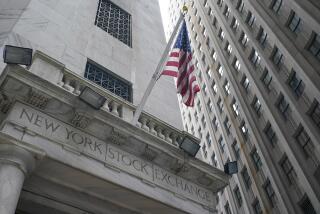Stocks and bond yields slide as coronavirus fears grip markets

- Share via
Fear dominated financial markets again Thursday, with U.S. stocks falling sharply on worries about the fast-spreading coronavirus outbreak. It’s the latest shudder in Wall Street’s most volatile week in more than eight years.
Major U.S. indexes lost roughly 3.5%, and Treasury yields touched more record lows in their latest yo-yo move. The slide nearly wiped out the surge stocks had ridden just a day earlier, which was motivated in part by hopes that moves by authorities around the world could cushion the economic fallout.
These vicious swings are likely to continue as long as the number of new infections continues to accelerate, many analysts and professional investors say. Thursday was the fourth straight day that the Standard & Poor’s 500 index moved at least 2%, the longest such stretch since summer 2011.
The growing understanding that the spread of infections — and resulting damage to the economy — may not slow anytime soon is pulling sharply on markets. That pull has taken turns this week with the increasingly worldwide push that governments and central banks are trying to give markets through spending plans and interest-rate cuts.
The yield on the 10-year Treasury note went as low as 0.901% for the first time, according to Tradeweb. Tumbling yields have brought the average rate on a 30-year fixed mortgage to a record low of 3.29%.
“It’s been a roller-coaster market in recent days for equity investors, and today we appear to be on the downward leg for that ride,” said Terry Sandven, chief equity strategist at U.S. Bank Wealth Management. “What you need is time, and unfortunately that is still going to result in volatility.”
In China, where the number of new infections has been slowing drastically, stocks trading in Shanghai have rallied nearly 12% since hitting a bottom Feb. 3. Factories there are gradually reopening, and a return to a sense of normal life may even be on the horizon after swift and severe actions by the government to corral the new form of coronavirus.
But elsewhere in the world, the mood is darker. There are about 17 times as many new infections outside China as in it, according to the World Health Organization.
In the U.S., the virus’ death toll climbed to 12. California declared a statewide emergency, Facebook is temporarily closing a Seattle office after a worker was diagnosed with the virus, and an industry group said the outbreak could cost airlines as much as $113 billion in lost revenue.
On Thursday, the S&P 500 fell 106.18 points, or 3.4%, to 3,023.94 — 10.7% below the record high it set Feb. 19. The Dow Jones industrial average slumped 969.58 points, or 3.6%, to 26,121.28, and the Nasdaq slid 279.49 points, or 3.1%, to 8,738.60.
Losses were widespread, and energy stocks in the S&P 500 dropped to their lowest level since March 2009, when they were emerging from the financial crisis.
“The Western world is now following some of China’s playbook — closing schools and declaring a state of emergency, for example — but there is a sense that this is too little, too late,” said Chris Beauchamp, chief market analyst at IG. (World Health Organization officials emphasized Thursday that it is not too late to beat back the spread of the virus.)
Travel-related companies continued to fall sharply on worries that frightened customers won’t want to confine themselves in planes or boats with others. Royal Caribbean Cruises sank 16.3%, Carnival fell 14.1%, and American Airlines Group lost 13.4%.
A growing number of companies are warning investors that the virus is hitting their sales and profits, and investors are left with a lot of uncertainty about just how much economic growth will be affected.
“We could probably drive a metaphorical truck between the upside and downside cases here,” said Jason Pride, chief investment officer for private wealth at Glenmede.
This week the S&P 500 posted a 4.6% jump Monday, a 2.8% loss Tuesday and a 4.2% climb Wednesday. In normal times, a move of even 1% would be notable.
Asian stock markets rose Thursday, riding the wave of optimism and hope that had sent the S&P 500 soaring Wednesday. U.S. congressional leaders reached a deal on an $8.3-billion bill to battle the outbreak, which the Senate passed Thursday, and the Bank of Canada followed the Federal Reserve’s lead in cutting interest rates.
Some economists expect the European Central Bank to make some kind of move in hopes of supporting markets before its March 12 meeting.
Several measures of fear in the market clenched tighter Thursday.
The yield on the 10-year Treasury sank to 0.91% from 0.99%. Gold climbed $25 to $1,668 an ounce as investors piled into investments seen as safe.
Benchmark U.S. crude oil fell 88 cents to $45.90 a barrel. Brent crude, the international standard, fell $1.14 to $49.99 a barrel.
More to Read
Inside the business of entertainment
The Wide Shot brings you news, analysis and insights on everything from streaming wars to production — and what it all means for the future.
You may occasionally receive promotional content from the Los Angeles Times.










